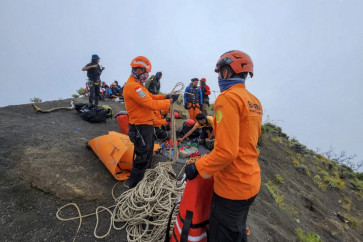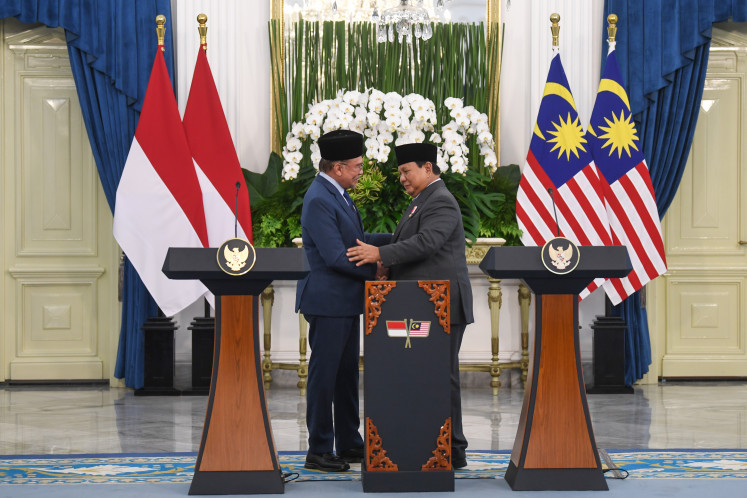Popular Reads
Top Results
Can't find what you're looking for?
View all search resultsPopular Reads
Top Results
Can't find what you're looking for?
View all search resultsMa’nene a reunion with the dead
Not forgotten: Torajanese men hold three mummies of Nek Tosai family members during the Ma’nene ritual
Change text size
Gift Premium Articles
to Anyone

Not forgotten: Torajanese men hold three mummies of Nek Tosai family members during the Ma’nene ritual.
Local people in North Toraja show their love and respect to the deceased by holding the Ma’nene ritual, where they reunite with the dead.
Rantepao in North Toraja, South Sulawesi, was cloudy and slightly misty when I visited the regency last August. Through narrow and hilly roads, reaching Pangala village takes three hours by car, but the journey is well worth it as along the way I witnessed the beautiful scenery of Toraja’s tongkongan traditional houses, sat among the vast paddy fields.
Sulestosai 59, a Pangala resident, guided us to a Toraja tomb or patane, in which lies a mummy, Yohanes Tampang, after being excavated by a member from the Tiranda family clan for a ritual called Ma’nene. Wearing dark glasses, black clothes and a batik headdress, Yohanes was to be cleaned, dried and redressed by the entire family.

The tomb: A motorcyclist passes ancient stone graveyard Lo’ko’mata.
In August, after harvesting and before the planting season, Ma’nene or “the cleaning of remains” begins in western Toraja in a ceremony described as the most complex burial ritual in the world. Family members bring out their dead loved ones every three years. They wash and dress them up with new clothes as well as repair their coffins.

The fiesta: Hundreds of Toraja men gather to perform the sisemba foot-fighting tradition, which is held after the Ma’nene ritual to pray for an abundant harvest.
Their love is reflected in their efforts to open the coffins and clean the dead. There is no sign of fear or disgust. They gather with joy and introduce the deceased to the family’s newest generation.
“We believe that departed family members are still with us, even if they have died hundreds of years ago,” Daniel Toding, a resident of the village, said.

Toding and his family were dressing their grandmother, Nek Tosai, for the ritual. “This is how we respect our forebears,” he added.
Ma’nene is observed by people embracing Aluk Todolo, an ancient belief imbued with deep adoration and respect for departed family members of whatever generation. The ritual originated in Baruppu village, where according to legend, a hunter, Pong Rumasek, found a dead human body while hunting. He was saddened and took the remains home for cleaning and dressing before being buried.
Since then, he had always been blessed with good crop harvests and hunting successes. Baruppu people thus began to believe that the remains of their ancestors should be taken care of and venerated. This belief later spread to Toraja, developing into the traditional ceremony known today.
Until the early 1900s, when Dutch missionaries started arriving, Toraja was still a region isolated from the outside world. Less than a century later, the region started getting increasingly popular among tourists. Tana Toraja, the other regency of Toraja, is now called “the second stop after Bali”, with an ever rising number of visitors annually.
— Photos by JP/Agung Parameswara









